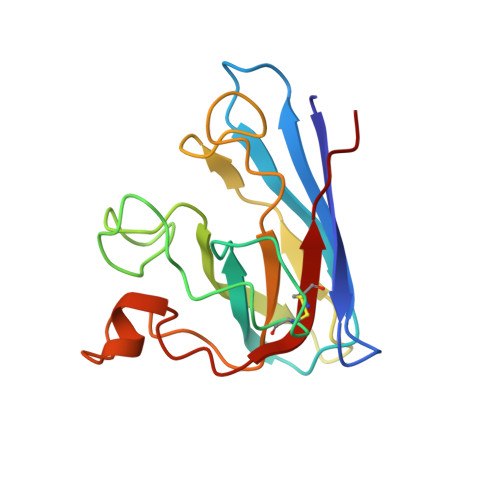The solution structure of reduced dimeric copper zinc superoxide dismutase. The structural effects of dimerization
Banci, L., Bertini, I., Cramaro, F., Del Conte, R., Viezzoli, M.S.(2002) Eur J Biochem 269: 1905-1915
- PubMed: 11952792
- DOI: https://doi.org/10.1046/j.1432-1033.2002.02840.x
- Primary Citation of Related Structures:
1L3N - PubMed Abstract:
The solution structure of homodimeric Cu2Zn2 superoxide dismutase (SOD) of 306 aminoacids was determined on a 13C, 15N and 70% 2H labeled sample. Two-thousand eight-hundred and five meaningful NOEs were used, of which 96 intersubunit, and 115 dihedral angles provided a family of 30 conformers with an rmsd from the average of 0.78 +/- 0.11 and 1.15 +/- 0.09 A for the backbone and heavy atoms, respectively. When the rmsd is calculated for each subunit, the values drop to 0.65 +/- 0.09 and 1.08 +/- 0.11 A for the backbone and heavy atoms, respectively. The two subunits are identical on the NMR time scale, at variance with the X-ray structures that show structural differences between the two subunits as well as between different molecules in the unit cell. The elements of secondary structure, i.e. eight beta sheets, are the same as in the X-ray structures and are well defined. The odd loops (I, III and V) are well resolved as well as loop II located at the subunit interface. On the contrary, loops IV and VI show some disorder. The residues of the active cavity are well defined whereas within the various subunits of the X-ray structure some are disordered or display different orientation in different X-ray structure determinations. The copper(I) ion and its ligands are well defined. This structure thus represents a well defined model in solution relevant for structure-function analysis of the protein. The comparison between the solution structure of monomeric mutants and the present structure shows that the subunit-subunit interactions increase the order in loop II. This has the consequences of inducing the structural and dynamic properties that are optimal for the enzymatic function of the wild-type enzyme. The regions 37-43 and 89-95, constituting loops III and V and the initial part of the beta barrel and showing several mutations in familial amyotrophis lateral sclerosis (FALS)-related proteins have a quite extensive network of H-bonds that may account for their low mobility. Finally, the conformation of the key Arg143 residue is compared to that in the other dimeric and monomeric structures as well as in the recently reported structure of the CCS-superoxide dismutase (SOD) complex.
Organizational Affiliation:
Department of Chemistry and Centro Risonanze Magnetiche, University of Florence, Italy.
















